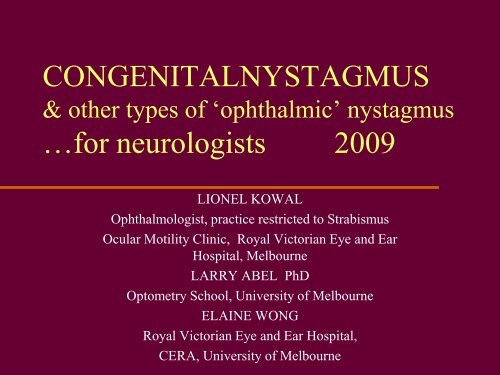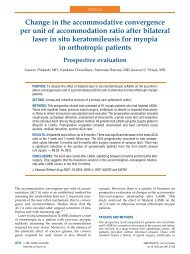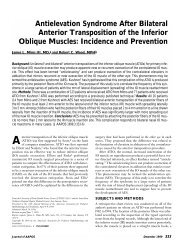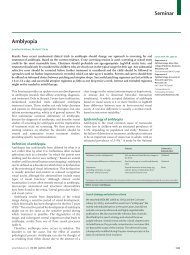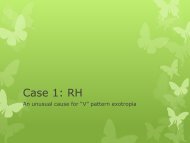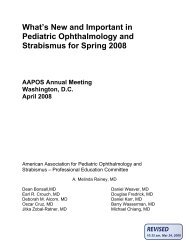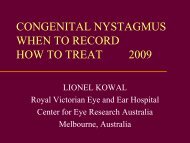NOSA.CN LECTURE.pdf - The Private Eye Clinic
NOSA.CN LECTURE.pdf - The Private Eye Clinic
NOSA.CN LECTURE.pdf - The Private Eye Clinic
Create successful ePaper yourself
Turn your PDF publications into a flip-book with our unique Google optimized e-Paper software.
CONGENITALNYSTAGMUS<br />
& other types of ‘ophthalmic’ nystagmus<br />
…for neurologists 2009<br />
LIONEL KOWAL<br />
Ophthalmologist, practice restricted to Strabismus<br />
Ocular Motility <strong>Clinic</strong>, Royal Victorian <strong>Eye</strong> and Ear<br />
Hospital, Melbourne<br />
LARRY ABEL PhD<br />
Optometry School, University of Melbourne<br />
ELAINE WONG<br />
Royal Victorian <strong>Eye</strong> and Ear Hospital,<br />
CERA, University of Melbourne
SELECTION BIAS<br />
Selection Bias :<br />
N seen by ENT, ophthalmologist,<br />
neurologist, neurosurgeon –<br />
all very different<br />
2
Is it important to detect<br />
‘ophthalmic’ nystagmus<br />
• If it’s confidently ‘congenital’ or<br />
‘ophthalmic’ you don’t have to<br />
worry about any neurological<br />
problem<br />
3
Terrible Terminology<br />
2 main types of ‘congenital’ N<br />
• lower case ‘c’: cN:<br />
any type of early onset N<br />
2 specific types of cN:<br />
• Upper case ‘C’: <strong>CN</strong>: Congenital N<br />
• LMLN: Latent Manifest Latent N<br />
4
Congenital N = <strong>CN</strong><br />
aka Congenital Motor N CMN,<br />
Congenital Sensory N CSN,<br />
Idiopathic Infantile N IIN<br />
Infantile N Syndrome INS [‘latest’ label]<br />
Subtype: Periodic Alternating N PAN<br />
≈ 10% in Melbourne<br />
5
LMLN<br />
Latent Manifest Latent Nystagmus<br />
aka FMNS = Fusional Maldevelopment N Syndrome.<br />
Can be obvious = manifest = MLN [Manifest Latent<br />
Nystagmus] or<br />
‘Pure’ LN [Latent Nystagmus], only apparent when<br />
one eye is covered<br />
6
*neurologically innocent<br />
<strong>CN</strong><br />
1. Convergence null *<br />
2. Eccentric null<br />
3. L beat to L of null<br />
4. R beat to R of null<br />
5. ± Latent component<br />
6. Horizontal, can be<br />
vertical**<br />
7. ± Oscillopsia**<br />
8. ± Strabismus<br />
LMLN<br />
1. Fast beat to fixing<br />
eye*<br />
2. Adduction null<br />
3. N on lateral gaze<br />
4. Latent component<br />
5. Horizontal, can be<br />
torsional **<br />
6. ± Oscillopsia**<br />
7. Strabismus in nearly all<br />
** NOT well known<br />
7
VIDEOS <strong>CN</strong><br />
• 3 videos:<br />
• 1. N on LG, PP<br />
• 2. null on RG<br />
• 3. conv null<br />
8
VIDEOS <strong>CN</strong><br />
• 3 videos:<br />
• 1. N on LG, PP<br />
• 2. Null on RG - Will<br />
adopt face turn to L<br />
when he wants to see<br />
clearly<br />
• 3. conv null<br />
9
VIDEOS <strong>CN</strong><br />
• 3 videos:<br />
• 1. N on LG, PP<br />
• 2. null on RG<br />
• 3. Conv null<br />
10
VIDEOS LMLN LN<br />
11
Why does <strong>CN</strong> occur 1<br />
• Poor symmetric acuity @ a<br />
critical time of visual<br />
development<br />
Sometimes there is continuing evidence of the<br />
initiating cause – egbilateral optic n<br />
hypoplasia, symmetric terrible refraction, cone<br />
dystrophy, cataract OU, albinism [macular<br />
hypoplasia or disc dysplasia]<br />
…and sometimes there is no evidence of the presumed / possible initiating cause –<br />
macular hemorrhages, terrible refraction that got better<br />
12
Why does <strong>CN</strong> occur<br />
2 other<br />
• Genetic reasons – the N waveform itself<br />
can be inherited as an isolated issue<br />
In CSNB: pathognomic waveform<br />
• Abnormal <strong>CN</strong>S : Peri Ventricular<br />
Leukomalacia PVL<br />
Many hypotheses / Multiple causes<br />
• abnormal circuit between fixation and ocular<br />
stabilisation systems<br />
• Abnormal proprioceptors in enthesis* [ cause, effect]<br />
* where tendon inserts into sclera 13
Why does LMLN occur<br />
• Asymmetry in motor or sensory<br />
development @ a critical time<br />
Strabismus, amblyopia, monocular<br />
cataract, PVL, unilateral optic n<br />
hypoplasia,…<br />
14
Effects of LMLN<br />
Unusual apparently incomitant strabismus<br />
• DHD – H strabismus [usueXodeviation]<br />
that can vary depending on wch eye is<br />
fixing<br />
• DVD – V strabismus …..<br />
Torsional & Horizontal N<br />
• ….no vestibular symptoms<br />
• ..drives variable face turns and head tilts<br />
• ...head shaking<br />
15
Whatever caused it, cN will then<br />
degrade acuity further.<br />
<strong>The</strong> amount of <strong>CN</strong> – associated degradation<br />
of acuity can be:<br />
1. Predicted by mathematically dissecting the<br />
waveform [NAFX factor - Cleveland]<br />
2. Estimated by assessing foveation time [the<br />
duration when N speed
2. Abnormal head posture<br />
30° into R<br />
gaze<br />
… will have Face Turn to L ~ 15°<br />
• 3. Reduced visual field<br />
Any large face turn: effectively restricted field of best acuity<br />
• 4. Strabismus in 30%<br />
Background 3%<br />
15° into R<br />
gaze<br />
Primary<br />
position<br />
15° into L<br />
gaze<br />
6/24 6/12 6/18 6/30 6/48<br />
30° into L<br />
gaze<br />
17
Principles of treatment of <strong>CN</strong><br />
• 1. Improve the foveation<br />
time / NAFX<br />
• 2. Improve 2° effects such<br />
as face turn<br />
• 3. Broaden the null zone<br />
18
Principles of treatment of <strong>CN</strong> :<br />
1. Improve foveation time & broaden null zone<br />
• Drugs – gabapentin, memantine<br />
Fairly new. Often effective.<br />
help a <strong>CN</strong> pt to pass a driving licence test!<br />
• Contact lenses<br />
SCL & HCL have an effect > optical effect<br />
interfere with local proprioception<br />
• Prism glasses [BOΔ]: induce<br />
convergence<br />
• Surgery<br />
Are the effects of these sometimes additive<br />
19
2. Improve 2° effects such as face turn<br />
•Prism glasses<br />
Induce a conv null for distance<br />
•Surgery<br />
20
Effects of treatment of <strong>CN</strong><br />
• Improved waveform may result in<br />
improved acuity potential limited by any<br />
associated pathology<br />
• Expanded null zone = improved field<br />
of same or better acuity &cosmetically<br />
improved N<br />
• Improved face turn – improved<br />
appearance and improved field<br />
21
Effects / Treatment of LMLN<br />
• Reduced acuity : make perfectly<br />
straight and convert MLN to LN<br />
• Face turn from adduction null: MR<br />
surgery<br />
• Head tilt from intorsion null: torsional<br />
surgery<br />
22
Defining the type of N<br />
•Do we need <strong>Eye</strong><br />
movement recordings<br />
EMR <br />
23
<strong>Clinic</strong>al Features : It should be possible<br />
to separate <strong>CN</strong> from LMLN in the office<br />
<strong>CN</strong><br />
1. Convergence null (better<br />
reading VA)<br />
2. L beat in L gaze / R beat in<br />
R gaze (either side of null<br />
zone)<br />
3. Eccentric null<br />
4. Latent component (can be<br />
pseudo-latent)<br />
5. Usu. horizontal, can be<br />
torsionalor vertical or all<br />
LMLN<br />
1. Fast beat to fixing eye<br />
2. Adduction null – can<br />
cause face turn<br />
3. Nystagmus on lateral<br />
gaze (moving away<br />
from adduction null)<br />
4. Latent component<br />
5. Can be horizontal or<br />
torsional or both<br />
24
Discriminating <strong>CN</strong> from LMLN<br />
in the office<br />
• CONVERGENCE<br />
NULL :<br />
• Both can have this –<br />
different mechanisms<br />
• Adduction null of<br />
LMLN can look like<br />
conv null of <strong>CN</strong><br />
• ECCENTRIC NULL :<br />
• Both can have this –<br />
different mechanisms:<br />
• LMLN: null in aDuction<br />
or Intorsion. If RE<br />
dominant, will have FT to<br />
R ± head tilt to R with<br />
both eyes. Different with<br />
LE fixing.<br />
• <strong>CN</strong>: eccentric null with<br />
RE fixing = LE fixing<br />
25
Discriminating <strong>CN</strong> from LMLN<br />
in the office<br />
• STRABISMUS :<br />
LMLN nearly 100%<br />
Non-expert may not always pick<br />
minimal strabismus<br />
<strong>CN</strong> 30%<br />
• VERTICAL /<br />
TORSIONAL<br />
COMPONENT:<br />
• LMLN: T more than<br />
V<br />
• <strong>CN</strong>: V more than T<br />
26
<strong>CN</strong> c.f. LMLN : L beat on L gaze, R<br />
beat on R gaze [Alexander’s Law]<br />
• <strong>CN</strong>: N LE on L of<br />
null zone, N RE<br />
on R of null zone<br />
• LMLN :<br />
• LE is fixing & is in<br />
LG: BE have N L<br />
• LATENT<br />
COMPONENT:<br />
Both can have this – <br />
different mechanisms<br />
• RE is fixing & is in<br />
RG: BE have N R<br />
…resembles <strong>CN</strong><br />
27
‘I AM WORSE THAN I USED TO BE’<br />
• LMLN:<br />
• Has lost binocularity<br />
and LN MLN<br />
• <strong>CN</strong>:<br />
• new neurological<br />
lesion has caused<br />
deterioration,<br />
or<br />
• Stress – common as a<br />
temporary mechanism,<br />
rarely permanent<br />
28
<strong>CN</strong> c.f. LMLN : L beat on L gaze, R<br />
beat on R gaze [Alexander’s Law]<br />
• <strong>CN</strong>: N LE on L of<br />
null zone, N RE<br />
on R of null zone<br />
• Resembles ‘N to<br />
fixing eye’ of LMLN<br />
esp if has ET or XT<br />
as well.<br />
• SO – IT’S NOT<br />
ALWAYS EASY<br />
TELLING <strong>CN</strong><br />
& LMLN<br />
APART<br />
29
EMR features – usually<br />
diagnostic<br />
<strong>CN</strong><br />
• Exponential increase<br />
in velocity in slow<br />
phase (unique)<br />
• Fast phase brings eye<br />
back to foveation<br />
LMLN<br />
• Decreasing velocity in<br />
slow phase (GPN)<br />
• Can be asymmetric in<br />
phase, amplitude or<br />
frequency<br />
30
PERIODIC ALTERNATING N<br />
PAN<br />
• <strong>CN</strong> waveform + alternating face turns<br />
PAN:<br />
= PAN<br />
Acquired form : ‘tight’ periodicity - Every 2 minutes<br />
Congenital form: usually aperiodic<br />
e.g. 8 minutes one way, 2 minutes other direction<br />
Not always recordable – takes too long for pt to maintain<br />
concentration on target<br />
31
AUDIT OF LK’s CLINICAL EXPERTISE<br />
– DIAGNOSING cN TYPE IN THE<br />
OFFICE<br />
• 1. By L Abel, the<br />
recording engineer by<br />
reviewing his findings<br />
and my referral notes<br />
• 2. By my [then]<br />
Fellow E. Wong who<br />
reviewed my files<br />
32
LARRY ABEL<br />
• 35 patients from the practice of author LK, a<br />
highly experienced clinician, were referred to<br />
the eye movement lab at my department for<br />
recording.<br />
• <strong>Clinic</strong>al diagnoses of nystagmus type(s)<br />
present was correlated with what was found<br />
upon recording<br />
33
Results of LA’s audit<br />
• <strong>Clinic</strong>al diagnosis: <strong>CN</strong> (10 patients)<br />
• Recording: 9 <strong>CN</strong>, 1 <strong>CN</strong> and LMLN<br />
• <strong>Clinic</strong>al diagnosis: LMLN (12 patients)<br />
• Recording:6 <strong>CN</strong>, 1 <strong>CN</strong> and LMLN, 5 LMLN<br />
• <strong>Clinic</strong>al diagnosis: <strong>CN</strong> and LMLN (11 patients)<br />
• Recording: 3 <strong>CN</strong>, 4 <strong>CN</strong> and LMLN, 4 LMLN<br />
• <strong>Clinic</strong>al diagnosis: unknown (2 patients)<br />
• Recording: 1 <strong>CN</strong>, 1 LMLN<br />
• <strong>Clinic</strong>al diagnosis <strong>CN</strong> : usually correct, many missed<br />
• <strong>Clinic</strong>al diagnosis LMLN: ~50% reliable. Overdiagnosed<br />
in the office, and many missed<br />
• <strong>Clinic</strong>al diagnosis <strong>CN</strong> with LMLN: Overdiagnosed in the<br />
office, some missed<br />
34
<strong>Clinic</strong>al correlations : Dr Elaine Wong [then<br />
Fellow]<br />
• Chart Review of cN pts n=84<br />
• 60 with EMR<br />
• 42 EMR & LK pre-EMR office<br />
diagnosis<br />
• 5 cases of PAN were excluded from analysis<br />
35
Overview: office c.f. lab diagnosis<br />
KOWAL MEACO 2009<br />
36
<strong>Clinic</strong>al and EMR Correlation<br />
Office diagnosis of <strong>CN</strong> is correct 80+% of the time<br />
Office diagnoses of LMLN & <strong>CN</strong>-LMLN not reliable<br />
37
Predictive Values of <strong>Clinic</strong>al Features – <strong>CN</strong><br />
Conv null present:<br />
70+% are <strong>CN</strong><br />
Conv null absent: ≥1/2<br />
are <strong>CN</strong> - absence of<br />
conv null doesn’t<br />
exclude <strong>CN</strong><br />
38
Predictive Values of <strong>Clinic</strong>al Features – <strong>CN</strong><br />
<strong>The</strong>se office findings are not diagnostic<br />
39
Predictive Values of <strong>Clinic</strong>al<br />
Features – LMLN<br />
If you don’t have<br />
N<br />
to fixing eye,<br />
90% are not<br />
LMLN<br />
If don’t have SPA,<br />
80% not LMLN.<br />
Latent N suggests<br />
LMLN ~60%<br />
If you demonstrate<br />
SPA,
Predictive Values of <strong>Clinic</strong>al<br />
Features – <strong>CN</strong> & LMLN<br />
Office findings<br />
are some guide<br />
41
Conclusions :<br />
<strong>Clinic</strong>al and EMR Correlation<br />
• Presence of convergence null – suggestive of <strong>CN</strong><br />
• Eccentric null and nystagmus to direction of gaze – less<br />
predictive of <strong>CN</strong><br />
• No reliable clinical signs for LMLN<br />
Do EMR!!!<br />
Gold standard for diagnosing types of cN<br />
No cardiologist would evaluate an arrhythmia without ECG<br />
No neurologist would evaluate epilepsy without EEG<br />
• Limitations exist! Can miss PAN!<br />
42
Does everyone with N need to be recorded<br />
• Not if you’re absolutely certain about<br />
the diagnosis and have all the<br />
information you need for management<br />
OR<br />
• If you don’t need to know e.g. N with<br />
insignificant face turn, good acuity, no<br />
neurological symptoms/ signs….<br />
43
SURGERY IN cN : LMLN<br />
• Straighten eyes perfectly<br />
• ± 10 Δ not enough: 0 Δ is needed<br />
• Will convert MLN to LN<br />
• Improve acuity, fix oscillopsia<br />
• Other surgeries for face turns and head tilts<br />
44
SURGERY IN cN : <strong>CN</strong><br />
• Eccentric null<br />
• Convergence null<br />
• Null in primary position<br />
• No definite null<br />
45
SURGERY IN <strong>CN</strong> : Hertle’s operation<br />
• Meta-analysis: ANY horizontal surgery in<br />
horizontal <strong>CN</strong> may improve acuity<br />
[probably by improving the waveform]<br />
even if the main aim of surgery has not<br />
been accomplished e.g. still has residual face turn<br />
• So: Why not try the most basic component<br />
of muscle surgery, ‘tenotomy – resuture’,<br />
and see if that improves the waveform<br />
• IT DOES!<br />
46
Eccentric null ≤ 20°<br />
L face turn<br />
Recess LMR 7mm & RLR 10 mm +<br />
tenotomy – resuture of the other<br />
two horizontal recti ~1 mm resection.<br />
If a small duction/version paresis is<br />
not created then the head posture<br />
will usually return.<br />
47
Eccentric null ≥ 25°<br />
L face turn<br />
Recess LMR 7mm , RLR 10 mm<br />
recess<br />
Resect other 2 recti for total 17mm<br />
per eye.<br />
If a small duction/version paresis is<br />
not created then the head posture<br />
will usually return.<br />
48
SURGERY IN <strong>CN</strong> : Convergence null<br />
• Prism adapt [no Fresnel] for max BOΔ<br />
• BMR x mm based on max BO Δ *<br />
+ tenotomy – resuture the lateral<br />
recti<br />
* Some: max BMR 3mm<br />
49
SURGERY IN <strong>CN</strong> : No null or null in primary<br />
•Tenotomy – resuture<br />
the horizontal recti<br />
Hertle series 400 <strong>CN</strong> surgeries: 8%<br />
50
SURGERY IN cN : PAN<br />
• Look for convergence null<br />
Prism adapt view BMR<br />
or<br />
• Tenotomy – resuture<br />
horizontal recti<br />
51
SURGERY IN cN : warnings<br />
• Albinism patients: have<br />
positive angle kappa & look<br />
divergent when they are<br />
straight to cover test<br />
52
OTHER TYPES OF CONGENITAL /<br />
OPHTHALMIC NYSTAGMUS<br />
1. Spasmusnutans<br />
2. Heiman Bielschowsky<br />
phenomenon<br />
53
Spasmusnutans<br />
• Early < 12mo<br />
• Asymmetric N<br />
• Head bobbing<br />
• DD: chiasmal tumour<br />
• Late<br />
• Persisting asymmetric<br />
N<br />
54
HBP<br />
• Slow vertical N in an<br />
eye that has developed<br />
or did have profound<br />
visual loss<br />
• Very under recognised<br />
• ~1Hz<br />
• Vision improving<br />
surgery [eg cataract<br />
surgery] can cause<br />
diplopia<br />
55
THE RECENT PAST AND THE<br />
IMMINENT FUTURE<br />
• Increasing use of EMR to study the<br />
effects of different treatments and<br />
their combinations on our patients<br />
with cN will help us understand<br />
their condition better and plan<br />
more effective treatments<br />
56
THANK YOU TO THOSE<br />
WHO TAUGHT & STILL<br />
TEACH ME ABOUT<br />
NYSTAGMUS: DRS.<br />
REINECKE, SPIELMAN,<br />
ABEL, DELLOSSO &<br />
HERTLE<br />
& THANK YOU TO THESE 2<br />
ACHIASMATIC BEAGLES WITH<br />
<strong>CN</strong> WHO CONTRIBUTED TO THE<br />
CLINICAL RECOMMENDATIONS<br />
IN THS TALK<br />
Discriminating <strong>CN</strong> from LMLN in the office<br />
Lakota<br />
Copper<br />
57


